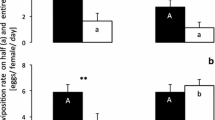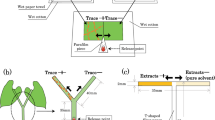Abstract
The larvae of the leaf-feeding weevil Oxyops vitiosa, a biological control agent of Melaleuca quinquenervia, are covered with a viscous orange coating that is thought to protect against generalist predators. This coating is gradually lost as the larvae drop to the ground and pupate in subterranean pupal cells. To test the antipredator activity of this species, four immature life stages (early instars, late instars, prepupae, pupae) were exposed to a common generalist predator, the red imported fire ant Solenopsis invicta. Choice tests were conducted by placing an O. vitiosa individual and a control larva of the weevil Neochetina eichhorniae into an arena containing a S. invicta colony and observing subsequent ant behaviors. S. invicta workers contacted O. vitiosa early instars, late instars, and prepupae less frequently than control N. eichhorniae larvae, and upon contact S. invicta was less likely to behave aggressively toward these O. vitiosa life stages than toward N. eichhorniae larvae. However, S. invicta contacted, attacked, and consumed naked (nonencased) O. vitiosa pupae and N. eichhorniae larvae with equal frequency. Encased O. vitiosa pupae buried in sand were not attacked compared to susceptible encased pupae on the sand surface. By shifting from a chemical defense during the larval stages to a physical defense during the pupal stage, O. vitiosa reduces the risk of attack by this generalist predator.
Similar content being viewed by others
REFERENCES
Balciunas, J. K., Burrows, D. W., and Purcell, M. F. (1994). Field and laboratory host ranges of the Australian weevil, Oxyops vitiosa (Coleoptera: Curculionidae), a potential biological control agent for the paperbark tree, Melaleuca quinquenervia. Biol. Control 4: 351-360.
Blum, M. S. (1981). Arthropod Defenses, Academic Press, New York.
Brophy, J. J., Boland, D. J., and Lassak, E. V. (1989). Leaf essential oils of Melaleuca and Leptospermum species from tropical Australia. In Boland, D. J. (ed.), Trees for the Tropics, Growing Australian Multipurpose Trees and Shrubs in Developing Countries, Sinauer Associates, Sunderland, MA, pp. 193-203.
Crawley, M. J. (1989). The successes and failures of weed biocontrol using insects. Biocontrol News Inform. 19: 213-223.
DeLoach, C. J., and Cordo, H. A. (1976). Life cycle and biology of Neochetina bruchi, a weevil attacking waterhyacinth in Argentina, with notes on N. eichhorniae. Ann. Entomol. Soc. Am. 69: 643-652.
Eisner, T. (1994). Integumental slime and wax secretion: Defensive adaptations of sawfly larvae. J. Chem. Ecol. 20: 2743-2749.
Goeden, R. D., and Louda, S. M. (1976). Biotic interference with insects imported for weed control.Annu. Rev. Entomol. 21: 325-342.
Hölldobler, B., and Wilson, E. O. (1990). The Ants, Belknap Press of Harvard University Press, Cambridge, MA.
Julien, M. H., and Griffiths, M. W. (1998). Biological Control of Weeds, a World Catalogue of Agents and Their Target Weeds, Fourth CAB International, Oxon, UK.
Lederhouse, R. C. (1990). Avoiding the hunt: Primary defenses of lepidopteran caterpillars. In Evans, D. L., and Schmidt, J.O. (eds.), Insect Defenses: Adaptive Mechanisms and Strategies of Prey and Predators, State University of New York Press, Albany, pp. 175-189.
Lofgren, C. S., Banks, W. A., and Glancey, B. M. (1975). Biology and control of imported fire ants. Annu. Rev. Entomol. 20: 1-30.
Montllor, C. B., Bernays, E. A., and Cornelius, M. L. (1991). Responses of two hymenopteran predators to surface chemistry of their prey: Significance for an alkaloid-sequestering caterpillar. J. Chem. Ecol. 17: 391-399.
Pavis, C., Malosse, C., Ducrot, P. H., Howse, F., Jaffe, K., and Descoins, C. (1992). Defensive secretion of first-instar larvae of rootstalk borer weevil, Diaprepes abbreviatus L. (Coleoptera: Curculionidae), to the fire-ant Solenopsis geminata (F.) (Hymenoptera: Formicidae). J. Chem. Ecol. 18: 2055-2068.
Purcell, M. F., and Balciunas, J. K. (1994). Life history and distribution of the Australian weevil Oxyops vitiosa (Coleoptera: Curculionidae), a potential biological control agent for Melaleuca quinquenervia (Myrtaceae).Ann. Entomol. Soc. Am. 87: 867-873.
Ramanoelina, P. A. R., Viano, J., Bianchini, J. P., and Gaydou, E. M. (1994). Occurrence of various chemotypes in Niaouli (Melaleuca quinquenervia) essential oils from Madagascar using multivariate statistical analysis. J. Agr. Food Chem. 42: 1177-1182
SigmaStat (1995). Jandel Scientific Software, Version 2.0.
Vander Meer, R. K. (1983). Semiochemicals and the red imported fire ant (Solenopsis invicta Buren) (Hymenoptera: Formicidae). Fla. Entomol. 66: 139-161.
Whitman, D. W., Blum, M. S., and Alsop, D. W. (1990). Allomones: Chemicals for defense. In Evans, D. L., and Schmidt, J.O. (eds.), Insect Defenses: Adaptive Mechanisms and Strategies of Prey and Predators, State University of New York, Albany, pp. 289-351.
Witz, B. W. (1990). Antipredator mechanisms in arthropods: A twenty year literature survey. Fla. Entomol. 73: 71-99.
Author information
Authors and Affiliations
Rights and permissions
About this article
Cite this article
Montgomery, B.R., Wheeler, G.S. Antipredatory Activity of the Weevil Oxyops vitiosa: A Biological Control Agent of Melaleuca quinquenervia. Journal of Insect Behavior 13, 915–926 (2000). https://doi.org/10.1023/A:1007870703128
Issue Date:
DOI: https://doi.org/10.1023/A:1007870703128




